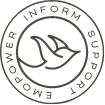Signs of Use
Determining if your child is using substances can be challenging. Many of the signs are common behaviors among teens and young adults. For example, shifts in mood or personality, behavioral changes, and mental health issues like depression or anxiety can often be mistaken for child substance use.
However, if you have reason to suspect use, don’t be afraid to err on the side of caution. Prepare to take action by asking direct questions to your child about drugs and seeking support resources if you confirm they are using.
Finding clues might be challenging unless you know what to look for, how to look for signs, and where to look. That’s where we come in!


